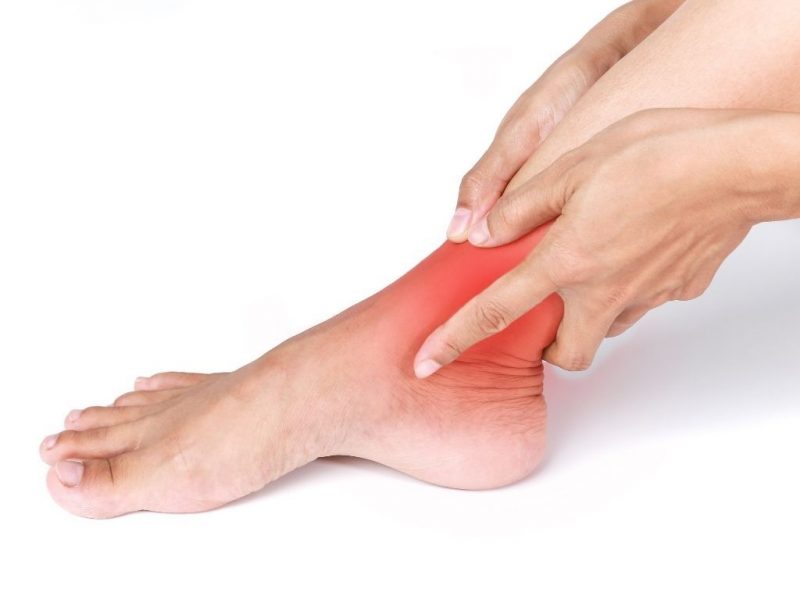There are few people in the adult population who have never had an ankle injury. Uneven or wet surfaces, a sudden loss of balance, or wearing high heels can cause ankle ligament sprains. An accident can happen in the blink of an eye, and an ankle ligament sprain, strain, or dislocation can make our life difficult for weeks, or even months.
This article shows you what to do with an ankle ligament sprain and how long it can take to heal:
- Why is the ankle so vulnerable to injuries?
- Treating ankle sprains: RICE, the at home care
- Recovery time for ankle injuries
- Ankle rehabilitation
Why is the ankle so vulnerable to injuries?
The vulnerability of the ankle is due to its anatomical structure. The ankle joint is held by a complex system of anterior and posterior ligaments. The ligaments hold the joint head in the joint socket, and to prevent lateral movements. If the ankle is under excess pressure, the ligaments can be easily damaged. The injury usually affects the anterior and medial ligaments. The ligaments can stretch or even tear partially or completely. A severe ankle injury can result in a broken bone or osteochondritis dissecans.
Ankle injuries are definitely painful, but it’s good to know when to see a doctor.
Go to the ICU if
- the pain is so severe that you are unable to move your ankle,
- the ankle is deformed,
- despite resting and icing the ankle, the pain and swelling don’t decrease.
If you see a doctor in time (within 48 hours of injury), the ligaments can heal without scarring. Scarring can be prevented by hyaluronate injections into the soft tissue.
Treating ankle sprains: RICE, the at-home care
In milder cases, when it’s not necessary to see a doctor, you can do a lot for recovery at home. The RICE therapy is definitely worth trying, which includes the following:
- Rest, as in resting the injured limb. It means resting the injured limb, which is especially important for ankle injuries. If you put pressure on your injured ankles, it can cause further injuries, and it will definitely make the current injury worse.
- Ice, as in icing. Icing reduces pain and swelling, so it’s highly recommended. However, make sure not to ice your foot for more than 15-20 minutes, but you can repeat the process several times.
- Compression, as in bandaging. Not too tight bandages secure the injured ankle and reduce swelling.
- Elevation, as in elevating the injured limb. Support your ankle with a pillow in a way that the ankle is placed above the level of the heart. By doing this, the accumulated fluid can easily drain into the bloodstream.
In addition, you can use various analgesic drugs (non-steroidal anti-inflammatory drugs), or creams, gels, or patches to reduce pain and inflammation. These have a similar mechanism, but they provide relief locally, on the applied area.
Partial tears and loose ligaments are treated with conservative methods, i.e., casts or braces (orthosis). However, a torn ligament always requires surgery.
For milder ankle injuries, it is important to start doing the strengthening and stretching exercises recommended by your physiotherapist as soon as the pain and swelling reduces (2-3 days after the injury). Following this plan can lead to a full recovery.
Recovery time for ankle injuries

A ligament injury takes 6-8 weeks to heal, but serious injuries may need months to completely heal. If treatment starts in time (hyaluronate injections), the recovery time can be cut by a third. If physiotherapy is part of the treatment plan, not only will the recovery time be reduced, but there is a chance of complete recovery (strength, flexibility, and range of motion of the ligaments are restored). However, if you skip physiotherapy, the damage to the ligaments can become permanent, causing further injuries and problems. The ligament can stretch permanently, or the joints can become loose. There are also modern physiotherapy procedures (iontophoresis, ultrasound, laser, magnetic treatments) that speed up the healing process and can lead to complete recovery.
It often happens that in case of a severe injury, patients don’t give the ankle enough time to heal, remove the braces and start using the injured limb prematurely. Because of this, the injured joint becomes unstable, which later leads to osteoarthritis or osteochondritis dissecans. It is therefore important to follow your doctor’s advice, even if you’re feeling better.
Ankle rehabilitation
The aim of rehabilitation is to strengthen the ankle and regain mobility of the ankle joint. In addition to doing the exercises the physiotherapist recommended, you also have to choose wisely what sports you do after your injury. At first, swimming and cycling are the best because they don’t put excess pressure on the ankle joints. Later, you can start using your ankles again by jogging and running. If you skip physiotherapy and jump into exercising as heavily as you did before, you risk further injuries to your ankle.
There is an extremely high risk of further injuries if your ankle has been injured once. Therefore, in addition, to gradually start using your ankle again, it’s important to keep wearing ankle braces, especially during exercise, because they help support your ankle. You should take ankle ligament sprains, strains, and dislocations seriously if you don’t want to avoid further injuries. Recovery time is long, but it’s better to wait for a few weeks until full recovery than to do this very long and painful process over and over again.

